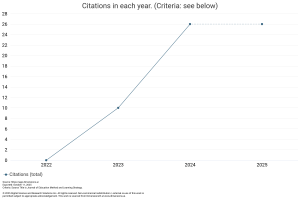Exploring Emerging Technologies in Online Medical Education: A Survey of Women's Online University
DOI:
https://doi.org/10.59653/jemls.v2i02.650Keywords:
Emerging Technologies, Online Medical Education, Instructional Tools, Teaching, Effectiveness, Gender InclusivityAbstract
This study explores the utilization and perceptions of emerging technologies in online medical education, with a focus on instructional tools and methods. The purpose is to assess the current landscape of technology integration, understand faculty and student perceptions, and identify potential applications for enhancing teaching effectiveness and promoting gender inclusivity. A quantitative research design was employed, involving a sample of 120 participants from three faculties: Medical, Pharmacy, and Stomatology. Data were collected through a structured online survey questionnaire, designed to gather information on demographics, technology utilization, teaching effectiveness perceptions, integration challenges, and opinions on gender inclusivity. Descriptive statistics were used to analyze quantitative data, while qualitative data from open-ended questions were analyzed thematically. The results indicate a significant utilization of emerging technologies in online medical education, with mobile learning and gamification being the most promising tools for teaching effectiveness. However, challenges such as technical support and resistance to integration were identified. Despite these challenges, participants generally perceived emerging technologies as effective in enhancing learning experiences, with potential for addressing gender disparities in medical education. In conclusion, the findings underscore the importance of leveraging emerging technologies to enrich online medical education, promote gender inclusivity, and enhance teaching effectiveness. Recommendations include providing adequate technical support and professional development for faculty, addressing resistance to technology integration, and further exploring the potential of emerging technologies in medical education.
Downloads
References
Andrade, M.S., & Alden-Rivers, B. (2019). Developing a framework for sustainable growth of flexible learning opportunities. Higher Education Pedagogies, 4(1), 1-16. https://doi.org 10.1080/23752696.2018.1564879
Angadi, N.B., Kavi, A., Shetty, K., & Hashilkar, N.K. (2019). Effectiveness of flipped classroom as a teaching-learning method among undergraduate medical students: an interventional study. Journal of Education and Health Promotion, 8, 211.
Auster, C.J. (2016). Blended learning as a potentially winning combination of face-to-face and online learning: an exploratory study. Teaching Sociology, 44(1), 39-48. https://doi.org 10.1177/0092055X15619217
Amiri, F., Quraishi, T., Hakimi, M., & Fazil, A. W. (2024). Assessing The Efficiency of Web-Hosted E-Learning Platforms in Afghanistan Academic Settings: An Exploration at Herat University. EDUTREND: Journal of Emerging Issues and Trends in Education, 1(1), 39–56. Retrieved from http://www.rcsdevelopment.org/index.php/edutrend/article/view/309
Collis, B., & Moonen, J. (2002). Flexible learning in a digital world. Open Learning: The Journal of Open, Distance and e-Learning, 17(3), 217-230. https://doi.org 10.1080/0268051022000048228
Edigin, E., Eseaton, P.O., Shaka, H., Ojemolon, P.E., Asemota, I.R., & Akuna, E. (2020). Impact of COVID-19 pandemic on medical postgraduate training in the United States. Medical Education Online, 25(1), 1774318. https://doi.org/10.1080/10872981.2020.1774318
Gearhart, D. (2008). Understanding flexible learning theory and how it is used in online learning. Hershey, PA: IGI Global. Retrieved from https://www.igi-global.com/chapter/understanding-flexible-learning-theory-used/30555
Goh, P.S., & Sandars, J. (2020). A vision of the use of technology in medical education after the COVID-19 pandemic. MedEdPublish. https://doi.org/10.15694/mep.2020.000049.1
Greenhalgh, T. (2001). Computer-assisted learning in undergraduate medical education. British Medical Journal, 322(7277), 40-44. https://doi.org/10.1136/bmj.322.7277.40
Hakimi, N., Hakimi, M., Hejran, M., Quraishi, T., Qasemi, P., Ahmadi, L., Daudzai, M., & Ulusi, H. (2024). Challenges and Opportunities of E-Learning for Women’s Education in Developing Countries: Insights from Women Online University. EDUTREND: Journal of Emerging Issues and Trends in Education, 1(1), 57–69. Retrieved from http://www.rcsdevelopment.org/index.php/edutrend/article/view/310
Hakimi, M., Shahidzay, A. K., & Aslamzai, S. (2024). Exploring Factors Influencing MOOC Adoption in Afghanistan's Educational Landscape. International Journal of Scientific Multidisciplinary Research, 2(1), 97-112. https://doi.org/10.55927/ijsmr.v2i1.8020
Han, S.G., Kim, Y.D., Kong, T.Y., & Cho, J. (2021). Virtual reality-based neurological examination teaching tool (VRNET) versus standardized patient in teaching neurological examinations for the medical students: a randomized, single-blind study. BMC Medical Education, 21(1), 493. https://doi.org/10.1186/s12909-021-02920-4
Hasas, A., Enayat, W., Hakimi, M., & Ahmady, E. (2024). A Comprehensive Review Of ICT Integration In Enhancing Physics Education. MAGNETON: Jurnal Inovasi Pembelajaran Fisika, 2(1), 36-44. https://doi.org/10.30822/magneton.v2i1.3106
Hakimi, M., Fazil, A. W., Ahmady, E., Qarizada, A., & Quraishi, T. (2024). Cyber Opportunities: Fostering Women’s Empowerment through E-Commerce in Afghanistan. Room of Civil Society Development, 3(1), 1–12. https://doi.org/10.59110/rcsd.275
Hasas, A., Hakimi, M., Shahidzay, A. K., & Fazil, A. W. (2024). AI for Social Good: Leveraging Artificial Intelligence for Community Development. Journal of Community Service and Society Empowerment, 2(02), 196-210. https://doi.org/10.59653/jcsse.v2i02.592
Hasas, A., Sadaat, S. N., Hakimi, M., & Quchi, M. M. (2024). Interactive Learning in Afghanistan: Feasibility of Implementing IoT Connected Devices in Classrooms. American Journal of Smart Technology and Solutions, 3(1), 8–16. https://doi.org/10.54536/ajsts.v3i1.2342
Hoffmann, D.S., Kearns, K., Bovenmyer, K.M., Cumming, W.F., Drane, L.E., Gonin, M., et al. (2021). Benefits of a multi-institutional, hybrid approach to teaching course design for graduate students, postdoctoral scholars, and leaders. Teaching & Learning Inquiry, 9(1), 218-240. https://doi.org/10.20343/teachlearninqu.9.1.15
Huynh, R. (2017). The role of e-learning in medical education. Academic Medicine, 92(4), 430. https://doi.org/0.1097/ACM.0000000000001596
Liang, Z.C., Ooi, S.B.S., & Wang, W. (2020). Pandemics and their impact on medical training: lessons from Singapore. Academic Medicine, 95(9), 1359-1361. https://doi.org/ 10.1097/ACM.0000000000003441
Naidu, S. (2017). How flexible is flexible learning, who is to decide and what are its implications? Distance Education, 38(3), 269-272. https://doi.org/ 10.1080/01587919.2017.1371831
O'Doherty, D., Dromey, M., Lougheed, J., Hannigan, A., Last, J., & McGrath, D. (2018). Barriers and solutions to online learning in medical education: an integrative review. BMC Medical Education, 18(1), 130. https://doi.org/10.1186/s12909-018-1240-0
Pei, L., & Wu, H. (2019). Does online learning work better than offline learning in undergraduate medical education? a systematic review and meta-analysis. Medical Education Online, 24(1), 1666538. https://doi.org/10.1080/10872981.2019.1666538
Pottle, J. (2019). Virtual reality and the transformation of medical education. Future Healthcare Journal, 6(3), 181-185. https://doi.org/10.7861/fhj.2019-0036
Rose, S. (2020). Medical student education in the time of COVID-19. Journal of the American Medical Association, 323(21), 2131-2132. https://doi.org/10.1001/jama.2020.5227
Ruiz, J.G., Mintzer, M.J., & Leipzig, R.M. (2006). The impact of E-learning in medical education. Academic Medicine, 81(3), 207-212. https://doi.org/10.1097/00001888-200603000-00002
Sargeant, J., Curran, V., Allen, M., Jarvis-Selinger, S., & Ho, K. (2006). Facilitating interpersonal interaction and learning online: linking theory and practice. Journal of Continuing Education in the Health Professions, 26(2), 128-136. https://doi.org/10.1002/chp.61
Saye, J.W., & Brush, T. (2002). Scaffolding critical reasoning about history and social issues in multimedia-supported learning environments. Educational Technology Research and Development, 50(3), 77-96. https://doi.org/10.1007/BF02505026
Watkins, K.E., & Marsick, V.J. (2020). Informal and incidental learning in the time of COVID-19. Advances in Developing Human Resources, 23(1), 88-96. https://doi.org/10.1177/1523422320973656
Zhang, K., & Aslan, A.B. (2021). AI technologies for education: recent research & future directions. Computers & Education: Artificial Intelligence, 2, 100025. https://doi.org/10.1016/j.caeai.2021.100025
Downloads
Published
How to Cite
Issue
Section
License
Copyright (c) 2024 Tamanna Quraishi, Musawer Hakimi, Nargis Hakimi, Atefeh Mohammad Khani, Nabila Zahid, Farida Gul Mohammadi

This work is licensed under a Creative Commons Attribution-ShareAlike 4.0 International License.
Authors who publish with this journal agree to the following terms:
- Authors retain copyright and grant the journal right of first publication with the work simultaneously licensed under a Creative Commons Attribution-ShareAlike that allows others to share the work with an acknowledgement of the work's authorship and initial publication in this journal.
- Authors are able to enter into separate, additional contractual arrangements for the non-exclusive distribution of the journal's published version of the work (e.g., post it to an institutional repository or publish it in a book), with an acknowledgement of its initial publication in this journal.
- Authors are permitted and encouraged to post their work online (e.g., in institutional repositories or on their website) prior to and during the submission process, as it can lead to productive exchanges, as well as earlier and greater citation of published work (See The Effect of Open Access).
























